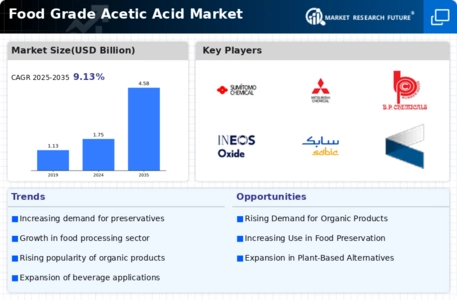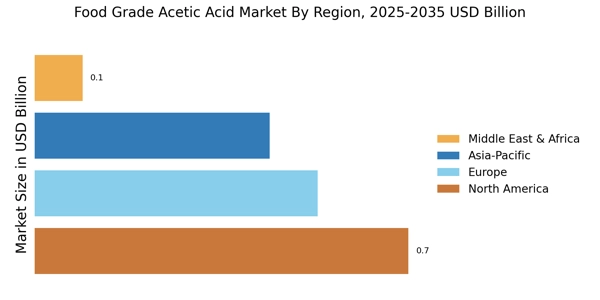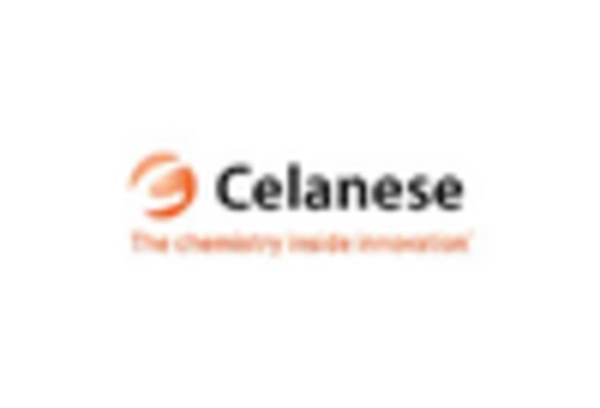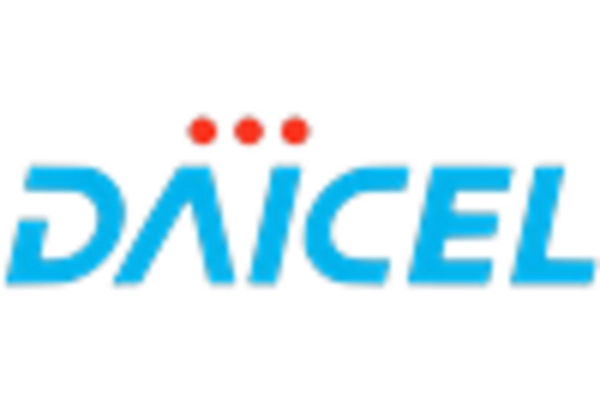Expansion of the Beverage Industry
The Food Grade Acetic Acid Market is significantly influenced by the expansion of the beverage sector, particularly in the production of vinegar-based drinks and flavored beverages. The versatility of acetic acid as a flavor enhancer and preservative has led to its increased incorporation in various beverage formulations. Recent data suggests that the beverage industry is projected to grow at a compound annual growth rate (CAGR) of over 5% in the coming years, which is likely to bolster the demand for food-grade acetic acid. This growth is attributed to changing consumer preferences towards healthier beverage options, including low-calorie and probiotic drinks. Consequently, manufacturers in the food-grade acetic acid market are expected to adapt their production strategies to cater to the evolving needs of beverage producers, thereby enhancing their market presence.
Increasing Use in Food Preservation
The Food Grade Acetic Acid Market is experiencing a notable increase in demand due to its effectiveness as a natural preservative. Acetic acid is widely recognized for its ability to inhibit the growth of harmful bacteria and fungi, thereby extending the shelf life of various food products. In recent years, the market has seen a surge in the adoption of food-grade acetic acid in pickling, sauces, and dressings. According to industry estimates, the food preservation segment is projected to account for a substantial share of the market, driven by consumer preferences for clean-label products. This trend indicates a shift towards natural ingredients, which aligns with the growing health consciousness among consumers. As a result, manufacturers are likely to invest in the production of food-grade acetic acid to meet this rising demand.
Growth in the Food Processing Sector
The Food Grade Acetic Acid Market is poised for growth due to the expansion of the food processing sector. As food processing techniques evolve, the demand for food-grade acetic acid as a key ingredient in various applications is expected to rise. Acetic acid is utilized in the production of condiments, marinades, and other processed foods, making it an essential component in the food supply chain. Recent statistics indicate that the food processing industry is projected to grow at a CAGR of around 4% over the next few years, which could lead to increased consumption of food-grade acetic acid. This growth presents opportunities for manufacturers to enhance their production capabilities and develop innovative products that cater to the needs of food processors.
Rising Popularity of Fermented Foods
The Food Grade Acetic Acid Market is benefiting from the rising popularity of fermented foods, which are increasingly favored for their health benefits. Fermented products such as kimchi, sauerkraut, and kombucha rely on acetic acid for their characteristic flavors and preservation. The global trend towards gut health and wellness has led to a surge in consumer interest in these products, driving demand for food-grade acetic acid. Market analysis indicates that the fermented food segment is anticipated to witness a robust growth trajectory, with projections suggesting a CAGR of approximately 7% over the next five years. This trend not only highlights the importance of acetic acid in food production but also suggests that manufacturers may need to scale up their operations to meet the anticipated increase in demand.
Regulatory Support for Natural Ingredients
The Food Grade Acetic Acid Market is likely to benefit from increasing regulatory support for natural ingredients in food products. Governments and regulatory bodies are progressively encouraging the use of natural preservatives and additives, which aligns with consumer demand for transparency and safety in food production. Recent legislative measures have focused on reducing synthetic additives, thereby creating a favorable environment for food-grade acetic acid. This regulatory shift is expected to enhance the market's growth potential, as manufacturers seek to comply with new standards while meeting consumer expectations. Furthermore, the emphasis on clean-label products is likely to drive innovation in the food-grade acetic acid sector, prompting companies to explore new applications and formulations that leverage the benefits of acetic acid.


















Leave a Comment